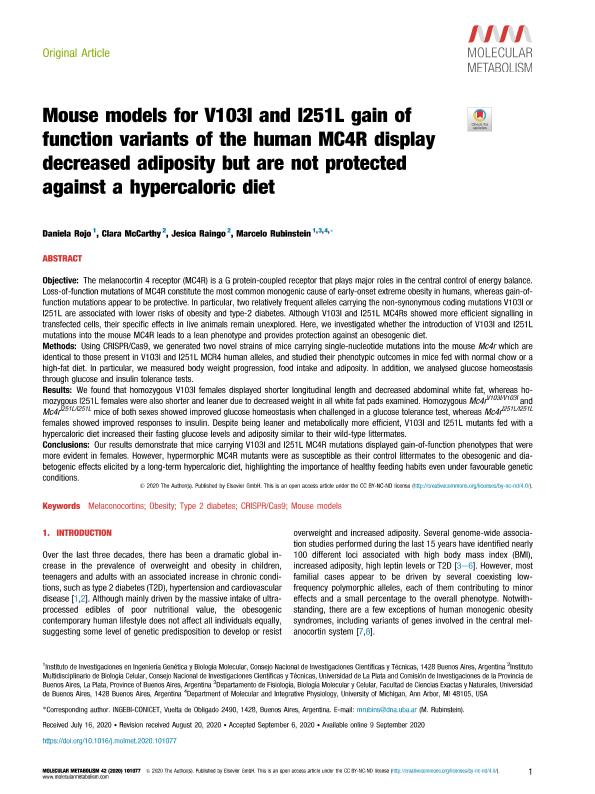Mostrar el registro sencillo del ítem
dc.contributor.author
Rojo, Daniela

dc.contributor.author
Mccarthy, Clara Inés

dc.contributor.author
Raingo, Jesica

dc.contributor.author
Rubinstein, Marcelo

dc.date.available
2022-03-28T21:09:13Z
dc.date.issued
2020-12
dc.identifier.citation
Rojo, Daniela; Mccarthy, Clara Inés; Raingo, Jesica; Rubinstein, Marcelo; Mouse models for V103I and I251L gain of function variants of the human MC4R display decreased adiposity but are not protected against a hypercaloric diet; Elsevier Gmbh; Molecular Metabolism; 42; 12-2020; 1-12
dc.identifier.issn
2212-8778
dc.identifier.uri
http://hdl.handle.net/11336/153970
dc.description.abstract
Objective: The melanocortin 4 receptor (MC4R) is a G protein-coupled receptor that plays major roles in the central control of energy balance. Loss-of-function mutations of MC4R constitute the most common monogenic cause of early-onset extreme obesity in humans, whereas gain-offunction mutations appear to be protective. In particular, two relatively frequent alleles carrying the non-synonymous coding mutations V103I or I251L are associated with lower risks of obesity and type-2 diabetes. Although V103I and I251L MC4Rs showed more efficient signalling in transfected cells, their specific effects in live animals remain unexplored. Here, we investigated whether the introduction of V103I and I251L mutations into the mouse MC4R leads to a lean phenotype and provides protection against an obesogenic diet. Methods: Using CRISPR/Cas9, we generated two novel strains of mice carrying single-nucleotide mutations into the mouse Mc4r which are identical to those present in V103I and I251L MCR4 human alleles, and studied their phenotypic outcomes in mice fed with normal chow or a high-fat diet. In particular, we measured body weight progression, food intake and adiposity. In addition, we analysed glucose homeostasis through glucose and insulin tolerance tests. Results: We found that homozygous V103I females displayed shorter longitudinal length and decreased abdominal white fat, whereas homozygous I251L females were also shorter and leaner due to decreased weight in all white fat pads examined. Homozygous Mc4rV103I/V103I and Mc4rI251L/I251L mice of both sexes showed improved glucose homeostasis when challenged in a glucose tolerance test, whereas Mc4rI251L/I251L females showed improved responses to insulin. Despite being leaner and metabolically more efficient, V103I and I251L mutants fed with a hypercaloric diet increased their fasting glucose levels and adiposity similar to their wild-type littermates. Conclusions: Our results demonstrate that mice carrying V103I and I251L MC4R mutations displayed gain-of-function phenotypes that were more evident in females. However, hypermorphic MC4R mutants were as susceptible as their control littermates to the obesogenic and diabetogenic effects elicited by a long-term hypercaloric diet, highlighting the importance of healthy feeding habits even under favourable genetic conditions.
dc.format
application/pdf
dc.language.iso
eng
dc.publisher
Elsevier Gmbh

dc.rights
info:eu-repo/semantics/openAccess
dc.rights.uri
https://creativecommons.org/licenses/by-nc-nd/2.5/ar/
dc.subject
MELANOCORTINS
dc.subject
OBESITY
dc.subject
TYPE 2 DIABETES
dc.subject
CRISP/CAS9
dc.subject
MOUSE MODELS
dc.subject.classification
Neurociencias

dc.subject.classification
Medicina Básica

dc.subject.classification
CIENCIAS MÉDICAS Y DE LA SALUD

dc.title
Mouse models for V103I and I251L gain of function variants of the human MC4R display decreased adiposity but are not protected against a hypercaloric diet
dc.type
info:eu-repo/semantics/article
dc.type
info:ar-repo/semantics/artículo
dc.type
info:eu-repo/semantics/publishedVersion
dc.date.updated
2021-09-06T17:24:55Z
dc.journal.volume
42
dc.journal.pagination
1-12
dc.journal.pais
Alemania

dc.journal.ciudad
Neuherberg
dc.description.fil
Fil: Rojo, Daniela. Consejo Nacional de Investigaciones Científicas y Técnicas. Instituto de Investigaciones en Ingeniería Genética y Biología Molecular "Dr. Héctor N. Torres"; Argentina
dc.description.fil
Fil: Mccarthy, Clara Inés. Consejo Nacional de Investigaciones Científicas y Técnicas. Centro Científico Tecnológico Conicet - La Plata. Instituto Multidisciplinario de Biología Celular. Provincia de Buenos Aires. Gobernación. Comisión de Investigaciones Científicas. Instituto Multidisciplinario de Biología Celular. Universidad Nacional de La Plata. Instituto Multidisciplinario de Biología Celular; Argentina
dc.description.fil
Fil: Raingo, Jesica. Consejo Nacional de Investigaciones Científicas y Técnicas. Centro Científico Tecnológico Conicet - La Plata. Instituto Multidisciplinario de Biología Celular. Provincia de Buenos Aires. Gobernación. Comisión de Investigaciones Científicas. Instituto Multidisciplinario de Biología Celular. Universidad Nacional de La Plata. Instituto Multidisciplinario de Biología Celular; Argentina
dc.description.fil
Fil: Rubinstein, Marcelo. Consejo Nacional de Investigaciones Científicas y Técnicas. Instituto de Investigaciones en Ingeniería Genética y Biología Molecular "Dr. Héctor N. Torres"; Argentina. Universidad de Buenos Aires. Facultad de Ciencias Exactas y Naturales. Departamento de Fisiología, Biología Molecular y Celular; Argentina. University of Michigan; Estados Unidos
dc.journal.title
Molecular Metabolism
dc.relation.alternativeid
info:eu-repo/semantics/altIdentifier/url/https://linkinghub.elsevier.com/retrieve/pii/S2212877820301514
dc.relation.alternativeid
info:eu-repo/semantics/altIdentifier/doi/http://dx.doi.org/10.1016/j.molmet.2020.101077
Archivos asociados
